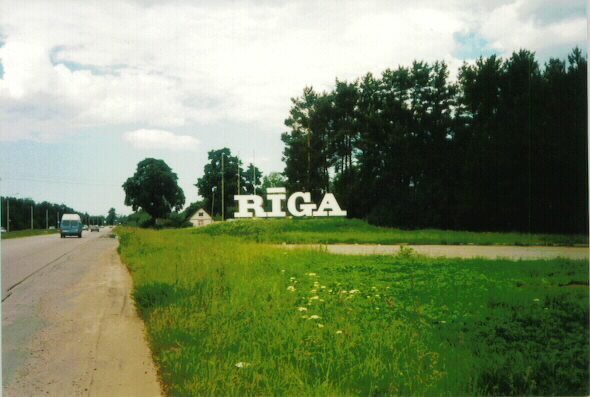
Entrance to Riga


Entrance to Riga

Brief History
Jewish
Population over the years
Languages
Synagogues and
Rabbis
University of Latvia Center
for Jewish Studies in Riga
Jewish Museum of
Riga
Synagogues of Latvia 1918-1940
Riga Picture Gallery
Ancestors Photos ![]()
Religious Life in the Riga Ghetto -
Testimony of Karl Schneider
Riga in Encylopedia of Jewish
Life before and after Holocaust-copyright Yad Vashem.
Maccabi Riga 1918-1933 Text and pictures
from Malz Archive
Maccabi Riga
Names in Text translated from Yiddish to English
Maccabi Riga Text and Pictures from
Latvian side of book
Topographic Maps of Eastern Europe -
History of the Pale of Settlement and
links to other very interesting articles
Riga was founded in 1201 by the Teutonic Order. In the 15th and
16th centuries Jews had economic ties with Riga. They were
allowed to come to Riga to work for limited periods of time but
could not live in the city permanently. In 1638 a hostel was
opened for them and in 1725 they received permission to
establish a Jewish cemetery. There were about 70 Jews in Riga at
this time and they left in 1743 when the Jews of Russia were
banished. In 1764 some rich Jewish families were classed as
"Protected Jews" and were considered as guardians of the
"foreign Jews" who had come to the hostel .In 1765 a Chevra
Kadisha was officially founded. In 1785 Jews traded in Riga but
had to register in a small town called Sloka.(Schlock) not far
from Riga. In 1813 they were granted permission to live in Riga
and there were 736 inhabitants comprising Protected Jews,Foreign
Jews and Schlock citizens. In 1858 they were allowed to own real
estate.The area around Moscow Road was known as "Moscow
Vorstadt" and was a main area of Jewish settlement. The Russians
evacuated the population of Kurland in 1915 while retreating
from the advancing Germans. They started with the Jews in March
or April of that year.At the end of the 19thC some Jews moved
out and lived in the centre of the City In 1941 they were forced
back into the Moscow area which became the Riga Ghetto.There
were Jewish intellectuals, professionals, and tradesmen but
between the 2 world wars about 10% of Latvian Jews were
paupers.
In 1940-1941 leading Jews were arrested and perished in Stalin's Gulag. The NKVD deported 14,000 inhabitants of Latvia on June 14th 1941 including about 5000 Jews, half from Riga. After the war some survivors returned and some Jews from the USSR settled in Riga. 23,000 Jews were registered in Riga in 1989.. There are at present about 9000 Jews in Riga.
1918-1934: Establishment of the Latvian Republic. Saima Period
15th May 1934 -1940: Karlis Ulmanis' presidency
1940-1941: Soviet occupation
22nd of June 1941 - 13th October 1944: German occupation
1944-1990: Soviet occupation
1990: Establishment of the Latvian Republic.
Jewish Population over the years
Kurland "mitnaggedim"spoke German and in 1881 half of Riga Jews considered their spoken language to be German. A strong German cultural influence dominated. Little by little others came from Belorussia( White Russia),Lithuania and Poland and spoke Yiddish. At the end of the 19thC Russian was added. During the 1920's and 1930's the youth learned the Latvian language.Hebrew was mastered as Zionism spread. According to the 1925 census,85% of the Jews in Latvia considered Yiddish to be their mother tongue. Yiddish was the language of Primary schools.
"Alt Neue Schul" was opened in1850.
The Great Choral Synagogue "Kar Schul" 25 Gogola Street was
consecrated in 1871. In 1941 300 Lithuanian Jewish refugees
sheltering in the synagogue,entire Jewish families from the
neighbourhood and passers-by in the street were burnt alive in
the synagogue. Ruins and a grey memorial stone carved with a
Magen David serve as a monument.
In 1873 a Soldiers Synagogue was founded.
By 1915 there were about 40 synagogues.
1873-1893 Rabbi Aharon Pompiansky
Followed by
Rabbi Shlomo Pucher
Rabbi Leib Kantor
References
Extracts from text by Marger Vestermanis Director of Jewish
Museum in Riga. Fragments of the Jewish History of Riga.
Extracts from text held at Kibbutz Shefayim by Association of
Latvian and Estonian Jews in Israel.
JewishGen
Latvia database
The Jewishgen Latvia
Database has information from a number of different sources.
Data has been drawn from Family Lists for Riga,Courland and
other shtetlach in Latvia, Recruits Enlistment registers,
Duma Voter's lists, Donations to Schools in Riga, Business
and Telephone Directories, Vedomosti (Russian Empire daily
newspapers) and many other sources. The latest additions
include a database of passport registration names from all
over the Russian Empire. Visitors to Riga for any length of
time had to register their passports with the police. It is
thus a great source of information as relatives visiting
Riga can be identified. It is not a passport application
database. We have also included the first databases from the
1897 All Russian Census with census names from Rezekne
and Krustpils. The 1897 database will be added to at
intervals.
HaMelitz index of Lithuanian and Latvian donors to
charitable causes
Yizkor Book Translations
Poor Jews Temporary Shelter-click on arrow
Please use back on your Browser to return to Riga
| Compiled by Arlene Beare Nov 28,1998 Contact: Arlene Beare Copyright©1998-2022 Arlene Beare Updated March 2022 |
|
|
|